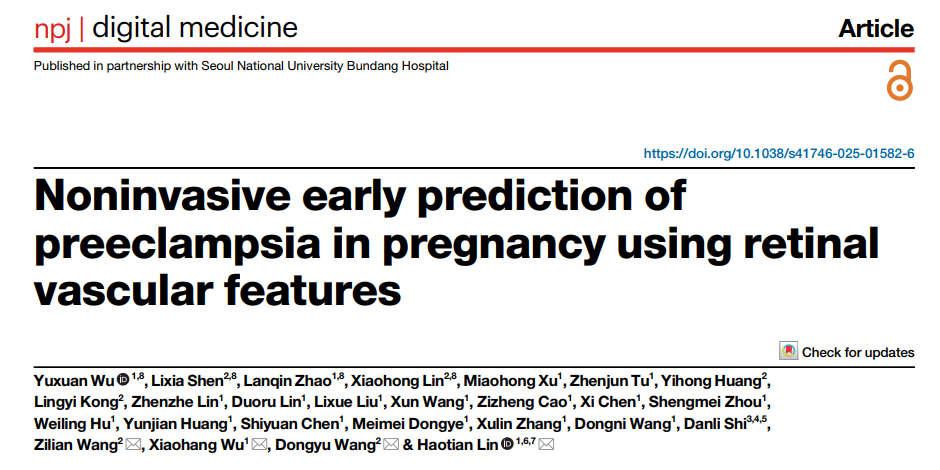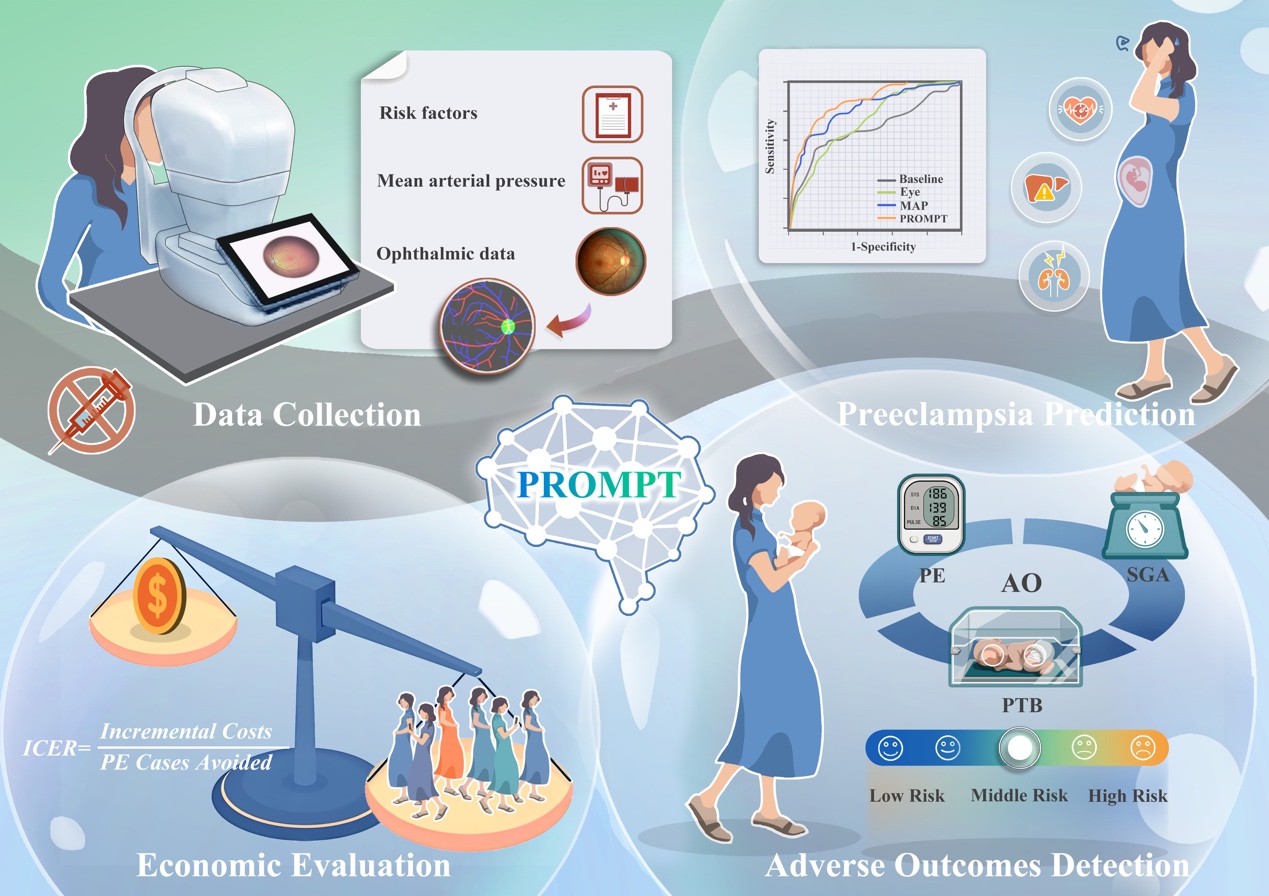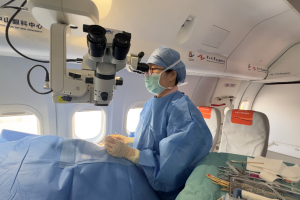
As the only organ in the human body where nerves and blood vessels can be directly observed in vivo, the eye serves as a unique "window" into systematic health. With the rapid development of artificial intelligence (AI) and ophthalmic imaging technology, this distinct advantage of the eye as a sentinel organ for monitoring systemic health is becoming increasingly prominent.
The prevention and management of pregnancy complications are crucial topics in perinatal medicine, yet a lot of challenges remain in current clinical practice. Preeclampsia (PE) is a pregnancy-specific disorder that seriously threatens maternal and neonatal health and is a leading cause of increased maternal and perinatal mortality. Apart from terminating the pregnancy, effective treatments for PE are lacking. Therefore, predicting PE is vital for early prevention and reducing maternal and infant mortality. However, effective, reliable and economical prediction method is lacking for PE prediction currently. Addressing this critical situation, the "Healthy China 2030" blueprint identifies implementation of a maternal and infant safety plan as a key goal, emphasizing the need to improve screening rates and the proportion of early diagnosis and treatment of PE, and reduce maternal mortality.
Currently, most biomarkers for predicting PE mostly rely on invasive and costly tests, making them difficult to implement widely in primary healthcare settings. To tackle this challenge, Professor Lin Haotian's team from Zhongshan Ophthalmic Center (ZOC), Sun Yat-sen University (SYSU) and Professor Wang Zilian's team from the Department of Obstetrics at the First Affiliated Hospital (FAH) of SYSU collaborated on a groundbreaking study. Using changes in retinal vascular features in early pregnancy as a starting point, they explored a new, non-invasive, convenient, and cost-effective disease management paradigm for "seeing" preeclampsia through the eye. The research paper, titled "Noninvasive Early Prediction of Preeclampsia in Pregnancy Using Retinal Vascular Features," was published online in the high-impact academic journal npj Digital Medicine on April 5, 2025. This work provides evidence to inform maternal and infant healthcare decisions in low- and middle-income countries and holds significant clinical importance for optimizing strategies to prevent and manage pregnancy-related disorders.

Figure 1: The research paper was published in npj Digital Medicine on April 5, 2025.
Since 2021, the collaborative team has built a large prospective "Maternal Eye Health" cohort. Using artificial intelligence deep learning-based algorithms to extract retinal vascular features, they constructed the PROMPT model (Preeclampsia Risk factors-Ophthalmic data-Mean arterial pressure Prediction Test) for PE prediction. The study aims to develop an objective and reliable early prediction tool for PE, offering a new solution to improve the early identification and management of PE and related adverse pregnancy outcomes. The tool holds significant clinical implications for reducing the morbidity and mortality of pregnant women and perinatal infants. Furthermore, the cost-effectiveness of the model was validated from a health economics perspective, demonstrating potential for application in screening and managing pregnancy complications in primary care settings.

Figure 2: Functional module design of the PROMPT model.
The study is the first to discover that significant changes in retinal vascular parameters, such as the artery-vein ratio and tortuosity, can be observed in the first trimester, much prior to the onset of PE. The PROMPT model, integrating metadata, mean arterial pressure, and retinal parameters, achieved an AUC of 0.87 (0.83-0.90) for predicting PE and 0.91 (0.85-0.97) for predicting preterm PE, significantly outperforming the baseline model (p<0.001). Additionally, compared to the baseline model containing only metadata, the PROMPT model increased the detection rate for severe adverse pregnancy outcomes from 35% to 41%. From a health economics standpoint, the PROMPT model proved dominant over other methods. It is estimated that screening 100,000 pregnant women using this model could effectively prevent 1,809 cases of PE and save over $50 million in total societal costs.
This study is the first to propose that retinal vascular features have the potential to serve as biomarkers for PE prediction. Compared to traditional methods, the PROMPT model offers the advantages of being non-invasive, convenient, and cost-effective, making it particularly suitable for large-scale application in primary healthcare settings. It holds significant clinical importance for reducing maternal and perinatal morbidity and mortality. The research team is promoting multi-center studies and real-world application, aiming to provide new economical and accessible solution for maternal and infant healthcare in low- and middle-income countries, while also offering important economic references for health policymakers.
About the Collaborative R&D Teams
Professor Lin Haotian's Team, Zhongshan Ophthalmic Center, Sun Yat-sen University
Collaborating with domestic and international universities and research institutions, Professor Lin Haotian's team from ZOC leverages interdisciplinary strengths to establish AI-based ophthalmic diagnosis, treatment, and clinical application systems. They further innovate algorithms based on ocular features to drive breakthroughs in intelligent screening and diagnosis technologies for ocular and systemic diseases, exploring new disease management models for "seeing" systemic diseases through the eye. The team has constructed a novel intelligent "digital hierarchical screening model" for eye diseases, enabling multi-scenario applications. Related technological achievements have been widely used in representative medical institutions across China and in countries and regions involved in the "Belt and Road" initiative, benefiting millions of residents and patients. They lead the innovation and development of key intelligent technologies for improving eye disease prevention and treatment capabilities.
Prof. Lin has led projects including the National Key R&D Program (excellent completion rating), Key Supported Project of the NSFC Major Research Plan, and Major Disease Intelligent Diagnosis and Treatment Project. He has published over 200 papers in top-tier international academic journals such as Nature, Nature Medicine, Nature Biomedical Engineering, and The Lancet Digital Health. The team holds 47 domestic and international patents and 12 software copyrights, with 5 technologies already transferred and applied in practice.
Professor Wang Zilian's Team, The First Affiliated Hospital, Sun Yat-sen University
Professor Wang Zilian is a leading figure in the Department of Obstetrics and Gynecology at the FAH of SYSU. She has extensive clinical experience and in-depth research expertise in perinatal medicine, particularly in managing high-risk pregnancies, maternal-fetal monitoring, multiple pregnancies, gestational diabetes mellitus, and pregnancies complicated by medical or surgical conditions. Her team conducts extensive research on pathogenesis and the early screening and diagnosis of risk factors. Focusing on hypertensive disorders of pregnancy and disorders of glucose and lipid metabolism, they are dedicated to enhancing the early screening and warning systems for pregnancy complications, moving the diagnostic threshold earlier.
The team has led many projects, including sub-projects of the National Key R&D Program, National Natural Science Foundation of China (NSFC) grants, projects from the National Health Commission, World Diabetes Foundation grants, Guangdong Provincial Natural and Social Development projects, Guangzhou Science and Technology Plan projects, and the SYSU 5010 clinical research program. They have published over 100 peer-reviewed papers, led the drafting of 2 clinical guidelines, and edited 3 specialist books.
Authorship Information
This study was completed through the collaboration of Professor Lin Haotian's team from ZOC, SYSU, and Professor Wang Zilian's team from the FAH of SYSU.
Dr. Wu Yuxuan (ZOC), Postdoctoral Fellow Shen Lixia (FAH), Assistant Researcher Zhao Lanqin (ZOC), and Dr. Lin Xiaohong (FAH) are co-first authors of the paper. Professor Lin Haotian (ZOC), Associate Chief Physician Wang Dongyu (FAH), Associate Chief Physician Wu Xiaohang (ZOC), and Professor Wang Zilian (FAH) are co-corresponding authors. ZOC is the primary affiliated institution.
Coinciding with the new century of Sun Yat-sen University and the 60th anniversary of ZOC, this project promotes the integration of medicine and engineering disciplines, cultivates interdisciplinary talent with international vision and innovative spirit, drives the independent training of young scientists and technological innovation, and contributes to addressing major scientific questions and serving national strategic needs.
Link to original article:
https://www.nature.com/articles/s41746-025-01582-6











